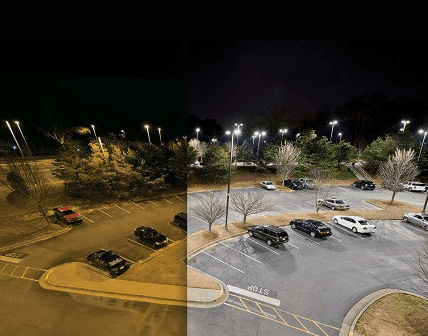Advanced LED Parking Lot Lights
A smart parking lot lighting system generates curb appeal and consolidates brand identity. In addition, quality pole lights ensure the safety of your patrons and employees, and the security of vehicles.
However, conventional lighting comes with poor light performance and tremendous power and maintenance costs.
The conversion to LED parking lot pole lights can help you reduce energy costs, minimize maintenance costs, and improve lighting performance. As a result, you will boost your business’ financial performance and increase the overall lighting experience of your patrons.
The Value of LED Outdoor Lights & Fixtures
Failing to ensure enough well-placed parking lot lights could result in injuries, vehicle damage, or even property damage. Subsequently, it might trigger complaints and lawsuits against your business and have a harmful impact on your reputation and finances. Additionally, poor lights minimize curb appeal and fail to inspire safety and security. Thus, poor lighting will eventually lead to loss of customers and inherent financial hardships.
Existing parking lot lights entail massive energy consumption, frequent maintenance costs, and sub-par lighting performance. Typically, legacy pole lights are either HID lamps, such as metal halide, high pressure sodium, or mercury vapor lamps.
Why Choose Tetrus LED Lights & Fixtures?
Specifically, customers are drawn to businesses whose parking lots inspire safety, security, cleanliness, and transparency. Moreover, they prefer locations that are visually appealing. As a result, commercial LED parking lot lighting can transform your dull, dimly-lit parking lot into your area’s attraction.
An LED parking lot completely changes the face of a business, be it a car dealership, shopping center, gas station, etc. Better lumen output, longer lifespan, eco-friendliness, a higher CRI, are just some of the features of LED pole light. In short, they bring long-term energy savings and low maintenance costs.
TETRUS: Your Light-time Partner
Tetrus is not your typical LED lighting company. We do not do offices, residential projects, or wire buildings. To explain, Tetrus focuses exclusively on outdoor LED lighting. As a result, you get to work with experts that have honed their skills over three decades of industry-specific experience. Here is why Tetrus is ALL you need when it comes to LED parking lot lighting:
We Sell Lumens, not Watts!
LED bulbs are intrinsically savers of energy and power cost. However, Tetrus is the ultimate energy and power cost saver because our LEDs. Why? Because we equip your parking lots with the highest efficacy LED parking lot lights on the market. Choose lights by how much light they provide, not by how much energy they use!
Premium Quality as Standard
Tetrus builds ONLY the best products with the best materials and the best technology. Thus, we engineer our LED parking lot fixtures to shine through the harshest weather conditions. Subsequently, we have made our LEDs to be sledgehammer-tough and ocean-proof. Therefore, they exceed the highest standards in the industry.
LEDs Built to Last
LED parking lot fixtures DO last longer than your conventional commercial parking lot lights, but they will still fail. Hence, when other companies’ LEDs fail, the fixtures can’t be serviced, and you need to replace the whole fixture. With Tetrus, you can replace ANY component in ANY fixture. Thus, service is made quick and easy because all components are standardized in all fixtures.
Warranty Honored Every Time
We have a 24/7 service line where you can reach us with any issues regarding our parking lot lights. Tetrus wants you to know we will always be there for you and we will always honor our warranty. Our standardized and serviceable modular design makes warranty affordable. Therefore, we will stand behind our warranties every time.
Tetrus Personalized Approach to LED Lights
Not all businesses are created equal. Just like not all LEDs are created equal. So, for us to devise the perfect parking lot solution for your business, we need to learn more about your business. As a result, we need your help to understand your industry and your location type, as well as your priorities.
We focus on understanding the needs and requirements of each of our clients. Subsequently, we can provide you with the most suitable products as well as the most comprehensive customer-specific services. Accordingly, we offer cash-friendly financing as well as other financing options.
If you are ready to upgrade your parking lot lights to ultra-efficient LEDs, schedule a meeting with one of our experts! Furthermore, you can always request industry-specific photometric data, a buyer’s guide, or a case study!
For more updates Follow us on Facebook: https://www.facebook.com/TetrusOfficial





